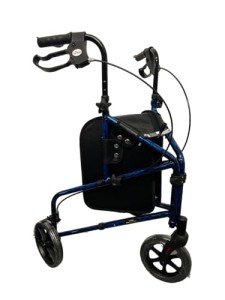
Best Rollator Walker
FollowOverview
-
Founded Date 14 July 1973
-
Sectors Creative and Design
-
Posted Jobs 0
-
Viewed 2
Company Description
The 10 Most Scariest Things About Medical Walker

Understanding Medical Walkers: A Comprehensive Guide
Medical walkers serve as important mobility aids for people recovering from surgery, managing persistent illnesses, or dealing with age-related mobility issues. These gadgets not just boost physical self-reliance however also improve safety, allowing users to browse their environments with higher ease. This article explores the types, benefits, functions, and considerations associated with medical walkers, along with some frequently asked questions.
Tabulation
- Kinds Of Medical Walkers
- Benefits of Using a Medical Walker
- Key Features to Consider
- Often Asked Questions
- Conclusion
1. Kinds Of Medical Walkers
Medical walkers are offered in various styles, catering to various requirements and preferences. The primary types include:
| Type of Walker | Description |
|---|---|
| Standard Walker | A rectangle-shaped frame with 4 legs, offering stability and assistance. |
| Two-Wheeled Walker | Comparable to a standard walker however equipped with wheels at the front for much easier motion. |
| Three-Wheeled Walker | A lightweight walker with 3 wheels, permitting for more maneuverability, suitable for indoor use. |
| Rollator Walker | A walker with four wheels, hand brakes, and a seat, suitable for longer ranges and resting needs. |
| Hemi Walker | Designed for individuals who can use only one hand, featuring a tripod-like style. |
2. Benefits of Using a Medical Walker
Using a medical walker provides numerous benefits that contribute to the user’s general well-being, consisting of:
- Increased Stability: Walkers provide a steady base of assistance, minimizing the risk of falls.
- Enhanced Mobility: They allow users to walk around more easily, promoting self-reliance.
- Discomfort Relief: By redistributing weight, walkers can alleviate discomfort in the joints, particularly in the hips and knees.
- Posture Support: These devices encourage appropriate posture, minimizing strain on the back.
- Improved Confidence: Users typically feel more protected using walkers, leading to much better self-confidence and increased activity levels.
3. Key Features to Consider
When choosing a medical walker, it’s crucial to examine various functions to discover the ideal fit. Here are some important elements to think about:
- Weight Capacity: Ensure the walker can support the user’s weight while preserving stability.
- Height Adjustment: Look for a walker with adjustable height settings to accommodate the user’s height and offer comfy grip.
- Material: Lightweight aluminum walkers are much easier to navigate, while steel walkers use more powerful support but might be heavier.
- Wheel Quality: If selecting a wheeled walker, consider the wheel size and tread. Larger wheels navigate uneven surfaces more easily.
- Seat Availability: If users will be walking for longer durations, a walker with an integrated seat can supply rest breaks when needed.
- Brakes: Hand brakes are specifically crucial for safety in rollator walkers to control speed and stop when needed.
Kinds of Walkers with Features Comparison Table
| Walker Type | Weight Capacity | Height Adjustment | Wheels | Seat Available | Brakes |
|---|---|---|---|---|---|
| Standard Walker | As much as 300 pounds | Yes | No | No | No |
| Two-Wheeled Walker | Up to 300 lbs | Yes | Yes | No | No |
| Three-Wheeled Walker | Approximately 250 pounds | Yes | Yes | No | No |
| Rollator Walker | Up to 400 lbs | Yes | Yes | Yes | Yes |
| Hemi Walker | As much as 250 lbs | Yes | No | No | No |
4. Frequently Asked Questions
Q1: Who must use a medical walker?A: Medical walkers are helpful for individuals recovering from surgical treatment, experiencing balance issues, or requiring support due to age-related mobility difficulties. Q2: Can a medical walker be adjusted?A: Yes, many

medical walkers are height-adjustable to accommodate various user heights, permitting for a more comfortable grip. Q3: How do I select the best walker for my needs?A: Consider factors such as the
user’s weight, height, kind of mobility concerns, and whether they need a seat or brakes. Testing the walker for convenience and stability before purchase is also a good idea. Q4: Are there any safety ideas related to using a medical walker?A: Yes, users should ensure they do not lean too
heavily on the walker, use it on stable and level surfaces, and constantly make sure
the brakes are engaged when seated or fixed. Q5: Can walking with a medical walker aid with rehabilitation?A: Absolutely. Medical walkers are typically advised as part of rehab programs as they motivate
exercise, which aids in healing and mobility improvement. 5.
Conclusion Medical walkers play an important function in enhancing the lifestyle for individuals facing mobility difficulties. With various types and features offered, picking the right walker includes considering the user’s specific requirements and circumstances. By understanding their benefits and correct use, people can restore independence, improve their mobility, and navigate their surroundings securely. Whether for short-term healing or long-lasting assistance, the best medical walker can substantially enhance a user’s overall well-being. Incorporating a medical walker into one’s day-to-day routine can be a transformative choice, making it much easier to get involved in life’s day-to-day activities while guaranteeing safety and confidence.


